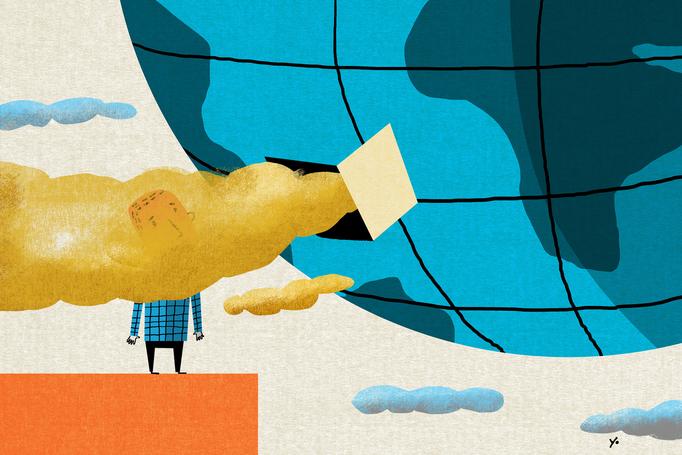Even during the summer holiday switch-off it was impossible to miss the takes about the Netflix satire Don’t Look Up.
Climate scientists related to the helplessness and panic felt by the astronomers in the movie who discovered a “planet killing” comet about to hit Earth, only to have their warnings mocked and ignored.
Critics panned it. Too obvious and laboured, they said. Which indeed it might be. But a purely cinematic critique of a parable about missing the point of planetary destruction does kind of … miss the point.
In the same lazy beach week that I watched Don’t Look Up, I also read the beautiful Bewilderment by Richard Power, with its wrenching depiction of a neurodivergent nine-year-old who simply cannot understand why adults are ignoring accelerating signs of environmental destruction.
Both book and movie made me think about how we report the climate crisis. Even in the grip of a pandemic, it is the emergency of our times, and raising the alarm is an ongoing editorial priority for the Guardian, in Australia and globally.
The undercurrent of that reporting, the bleak truth beneath every story, is the gap between what the science says to be true, and what we do about it. In Australian public policy that gap is a yawning chasm, a reality that has been drowned out, wilfully ignored and wickedly misrepresented during a decade of climate “wars”.
The “wars”, of course, were never about who had the best plan to avoid unfolding environmental catastrophe, but rather which party or faction could most effectively turn not having any plan to their immediate political advantage, or which was best at misrepresenting and destroying a competitor’s workable ideas. Maybe that’s why it was so hard to laugh during Don’t Look Up when Meryl Streep, playing the US president who had just been told of impending global destruction, decided the best thing to do was to “sit tight and assess” until after the midterms.

Anyone approaching the issue with basic scientific literacy sees the disconnect between science and politics. Most have coped by focusing on the practical, the possible, the incremental changes that inch things forward. Not allowing the idea of perfect climate policy to become the enemy of the good might have felt more consequential had more good policy been on offer.
But through that lens, there was incremental progress towards the end of 2021. Both major parties committed to a target of net zero emissions by 2050, although as Guardian Australia’s environment editor, Adam Morton, pointed out, the Coalition’s commitment included no new policies, largely relied on unproven technology and did not actually get the country to net zero. Or, as our political editor, Katharine Murphy, put it, it was really just “the status quo with some new speculative graphs”.
Then Labor announced a 2030 target of a 43% reduction in emissions, more ambitious than the Coalition’s 26-28%, but still carefully calibrated to try to withstand yet another scare campaign. Rather than dusting off their hyperbolic lines about the destruction of the economy, business and employer groups supported Labor’s policy, leading Morton to tentatively wonder whether the climate wars might be over.
At the moment a political truce around inadequate policy seems like a best possible scenario. Maybe even followed by modest progress during the next term of parliament. But we are long past the time for incrementalism.
With rapidly diminishing years left before the world runs out of time to decarbonise, this year’s election has to move beyond the tired analysis about how Australian parties may find some slick or sneaky climate message that satisfies voters in “coal seats” as well as those in the inner city, as if “coal” seats are somehow immune from the ecological and economic impacts of global heating. The questions demanded by that gap between science and political reality can no longer be trumped by backroom strategic games.
Does Australia really want to play its part in limiting global warming to 1.5C? Do those vying for political office really understand the consequences of failing to meet that target? If they are committed to it, why is the government spending $600m on a new gas-fired power plant in New South Wales – to take just one of many examples of policy blatantly contradicting promises. Its own market operator says it’s not needed and the International Energy Agency said almost a year ago there could be no new investments in coal, oil or gas if the world was to have even a shot of meeting that goal.
Perhaps the mobilising “Voices of” or teal independents will force these questions on to the agenda, or if not them, the moderate Liberals whose seats they threaten. Perhaps the possibility of a hung parliament and the need to deal with some of those independents will steer the debate back towards something resembling sane. Perhaps the overwhelming concern of voters will finally hold sway.
Guardian Australia has worked to elevate the climate debate since its establishment in 2013, with news, analysis, video series and podcasts. We’ll be intensifying our efforts this election year, through news and analysis from Murphy and Morton and environment reporters Lisa Cox and Graham Readfearn, through Readfearn’s factchecking column Temperature Check and Peter Hannam’s reporting on the green economy.
However the politics plays, we’ll stick with the task of asking the questions demanded by the science.









